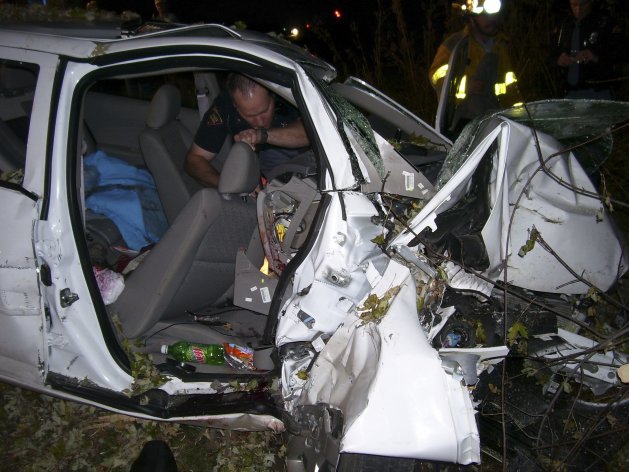
We’re getting a better understanding of what drove General Motors (GM) to bankruptcy in 2009.
Newly unearthed legal documents show GM knew about faulty ignition switches on the Chevrolet Cobalt and other vehicles before it even began selling the models in 2004. It launched the vehicles anyway, figuring owners would be able to get off the road safely if the car shut down during travel. GM made “a business decision not to fix this problem,” a company engineer explained under oath in 2013, according to the Wall Street Journal, as part of a lawsuit involving a Georgia woman who died in a Cobalt that shut down at highway speeds and crashed.
For a moment, put aside the obvious safety problem of cars shutting down on the highway, and think only of a flaw that might make your car inoperable. GM was already in a tailspin in 2004, losing market share to Japanese rivals and getting pummeled by auto critics for the shoddy quality of its vehicles — small cars especially. GM promoted the new Cobalt as an import slayer, on par with standard-bearers such as the Honda Civic and Toyota Corolla.
Most critics didn’t buy it. “Not all that impressive,” Consumer Reports declared of the Cobalt, dinging the car for flabby steering, uncomfortable seats, gappy interior panels and other shortcomings. “It’s more fulfilling as a rental than as a car you’d buy.” If only they had known.
Now for the safety bit. As part of the 2013 lawsuit, GM officials suggested the Cobalt could be safely brought to rest if the ignition switch failed and the key inadvertently slipped from “on” to “off.” Too bad they didn’t put that in the sales brochure. “Just coast to a pleasing halt!” Chevy could have enticed buyers. You can imagine the emergency meetings at Honda and Toyota as they pondered whether to copy this groundbreaking, surprise-shutdown feature.
Culturally rotten
What still isn’t known is how high up at GM the decision to send deeply flawed vehicles onto American roads went. But something is culturally rotten at a company if mid-level managers responsible for safety can rationalize away something as severe as a high-speed shutdown. Nobody up the chain is telling them quality is crucial. What the bosses probably are saying is, keep costs down, no matter what. Such contempt for customers often leads straight to the corporate graveyard. Come to think of it, that's exactly what happened to GM.
The automaker says the faulty switches have now been linked to 31 crashes involving 12 deaths, and an unknown number of injuries. So far, the company has recalled 1.6 million vehicles with the problem. Several federal investigations are underway and the automaker or certain executives could face criminal charges.
All this happened at the “old GM,” before bankruptcy, and the automaker is genuinely a different company now. GM has had four CEOs since the last of the deadly ignition switches rolled off the line. The current chief, Mary Barra, worked at GM at the time but says she was never involved with the tainted vehicles and didn’t know of the problem until this year. Meanwhile, GM is finally building world-class vehicles in nearly every category, rather than laughingstock passenger cars meant to fill dealerships and give customers something else to look at when they come in to check out a truck or SUV.
But will consumers buy it? Will they really differentiate between two different GMs separated by a bankruptcy filing? That seems doubtful. GM is only part of the way through the rehabilitation of its brand, convincing some new buyers to try a GM product but still failing to connect with many others, including some permanently disgusted by the automaker’s 2009 federal bailout.
GM may be able to limit its legal payouts to some plaintiffs, since the bankruptcy filing provides a liability shield for incidents that occurred before July 10, 2009. That liability resides with the old GM — the entity responsible for leftover debts from the pre-bankruptcy days — which is almost out of money. But invoking that technicality could cost GM a lot more in bad publicity — and lost future sales — than it saves in legal payouts.
Sen. Richard Blumenthal (D-Ct.) has now joined safety advocates in calling on GM to establish a fund to compensate victims and their families, regardless of whether the liability shield legally absolves the company. GM, now handsomely profitable, can probably afford such a fund. “Even if GM said we’re going to pay out several billion dollars, it would hardly move the needle in my fair-value estimate,” says David Whiston, a senior equity analyst at Morningstar. “I’m still very bullish on the stock.” Investors seem to agree: GM stock has dipped since it first announced the recall in early January, but it hasn’t cratered the way, say, BP’s (BP) stock did after the disastrous Gulf oil spill in 2010.
Barra is scheduled to testify before Congress on April 1, which would be a timely moment to announce a generous compensation program for anybody harmed in one of GM’s shutdownmobiles. That would be a way for GM to say, we don’t just admit a mistake, we’re also committed to fixing it wherever possible.
The old GM would have lawyered up and fought every claim. The new GM? We don’t know yet, but we will soon find out just how new it really is. LINK


